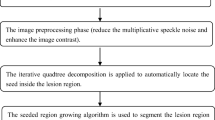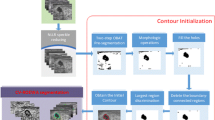Abstract
Based on seed region growing method, lesion segmentation for ultrasound breast tumor images often requires manual selection of the seed point, which is both time-consuming and laborious. To overcome this limit, this paper attempts to explore an automatic method for finding the seed point inside the tumor. Two criteria combining iterative quadtree decomposition (QTD) and the gray characteristics of the lesion are thus designed to locate the seed point. One is to seek the biggest homogenous region and the other is to select the seed region where the seed point is found. Furthermore, this study validates the proposed algorithm through 110 ultrasonic breast tumor images (including 58 malignant tumor images and 52 benign tumor images). According to the needs of the seed region growing algorithm, if the seed point is found inside the tumor, it means the proposed method is correct. Otherwise, it means that the method is a failure. As the quantitative experiment results show, the proposed method in this paper can automatically find the seed point inside the tumor with an accuracy rate of 97.27 %.





Similar content being viewed by others
References
Adams R, Bischof L (1994) Seeded region growing. Pattern Anal Mach Intell 16:641–647
Chen D, Chang R, Chen C, Ho M, Kuo S, Chen S, Hung S, Moon WK (2005) Classification of breast ultrasound images using fractal feature. Clin Imaging 29:235–245
Cheng HD, Shan J, Wen J, Guo Y, Zhan L (2010) Automated breast cancer detection and classification using ultrasound images: a survey. Pattern Recogn 43:299–317
El-Harby AA, Behery GM (2008) Qualitative image compression algorithm relying on quadtree, International Journal on Graphics. Vis Image Process 8:41–50
Felzenszwalb PF, Huttenlocher DP (1998) Image segmentation using local variation. Proc IEEE Comput Soc Conf Comput Vis Pattern Recognit 98–104
Gholinezhad S, Jamshidi S, Hajizadeh A (2015) Quad-Tree decomposition method for areal upscaling of heterogeneous reservoirs: application to arbitrary shaped reservoirs. Fuel 13:9659–670
Gonzalez RC, Woods RE (2002) Digital image processing, 2nd edn. Prentice Hall, Inc, Upper Saddle River
Guo Y, Şengür A, Tian J-W (2016) A novel breast ultrasound image segmentation algorithm based on neutrosophic similarity score and level set. Comput Methods Programs Biomed 123:43–53
Hojjatoleslami SA, Kittler J (1998) Region growing: a new approach. IEEE Trans Image Process 7(7):1079–1084
Huang QH, Lee SY, Liu LZ, Lu MH, Jin LW, Li AH (2015) A robust graph-based segmentation method for breast tumors in ultrasound images. Ultrasound Med Biol 41(6):1737–1748
Kaur M, Kaur J, Kaur J (2011) Survey of contrast enhancement techniques based on histogram equalization. Int J Adv Comput Sci Appl 2:138–141
Liu B, Cheng HD, Huang JH, Tian JW, Liu JF et al (2009) Automated segmentation of ultrasonic breast lesions using statistical texture classification and active contour based on probability distance. Ultrasound Med Biol 35:1309–1324
Ma F, Bajger M, Slavotinek JP, Bottema MJ (2007) Two graph theory based methods for identifying the pectoral muscle in mammograms. Pattern Recogn 40:2592–2602
Madabhushi A, Metaxas DN (2003) Combining low-, high-level and empirical domain knowledge for automated segmentation of ultrasonic breast lesions. IEEE Trans Med Imaging 22:155–169
Moi Hoon Y, Edirisinghe EA, Bez HE (2008) A novel algorithm for initial lesion detection in ultrasound breast images. J Appl Clin Med Phys 9:181–199
Noble JA, Boukerroui D (2006) Ultrasound image segmentation: a survey. IEEE Trans Med Imaging 25(8):987–1010
Peng G, Lee W-M, Roubidoux MA (2016) Automated 3D ultrasound image segmentation to aid breast cancer image interpretation. Ultrasonics 65:51–58
Pisani P, Parkin DM, Ferlay J (1993) Estimates of the worldwide mortality from eighteen major cancers in 1985. Implications for prevention and projections of future burden. Int J Cancer J Int Cancer 55:891–903
Poonguzhali S, Ravindran G (2006) A complete automatic region growing method for segmentation of masses on ultrasound images. Int Conf Biomed Pharm Eng 88–92
Shan J, Cheng HD, Wang Y (2008) A novel automatic seed point selection algorithm for breast ultrasound images. 19th International Conference on Pattern Recognition 1–4
Shan J, Cheng HD, Wang Y (2012) Completely automated segmentation approach for breast ultrasound images using multiple-domain features. Ultrasound Med Biol 38:262–275
Yu Y, Acton ST (2002) Speckle reducing anisotropic diffusion. IEEE Trans Image Process 11:1260–1270
Zhai G, Lin W, Cai J, Yang X, Zhang W (2009) Efficient quadtree based block-shift filtering for deblocking and deranging. J Vis Commun Image Represent 20:595–607
Zhang H, Foo SW, Krishnan SM, Thng CH (2004) Automated breast masses segmentation in digitized mammograms. IEEE Int Workshop Biomed Circuits Syst
Acknowledgments
This work is supported in part by the National Basic Research Program of China (2011CB707504), Colleges and universities domestic visiting scholar project of young backbone teachers in Shandong province and Youth fund projects of Jining Medical University.
Author information
Authors and Affiliations
Corresponding authors
Rights and permissions
About this article
Cite this article
Fan, H., Ma, J., Fan, H. et al. Iterative quadtree decomposition based automatic selection of the seed point for ultrasound breast tumor images. Multimed Tools Appl 76, 3505–3517 (2017). https://doi.org/10.1007/s11042-016-3761-z
Received:
Revised:
Accepted:
Published:
Issue Date:
DOI: https://doi.org/10.1007/s11042-016-3761-z




